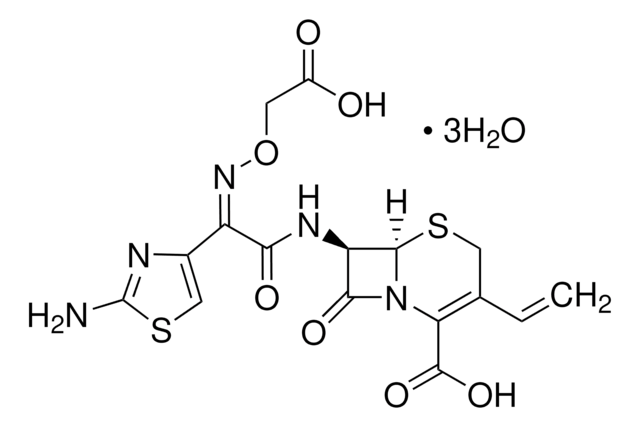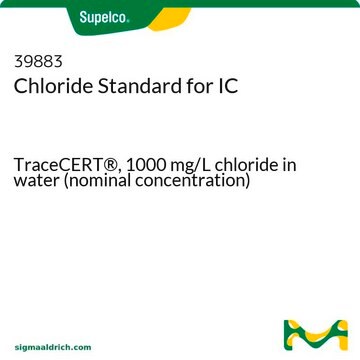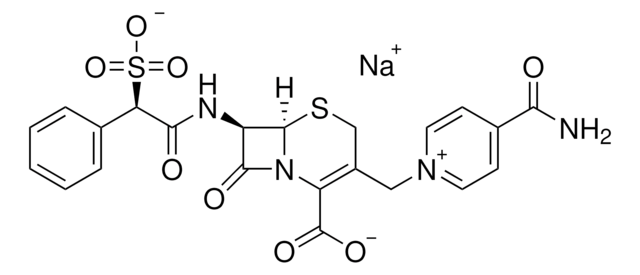18588
Cefixime trihydrate
suitable for microbiology, ≥98.0% (HPLC)
About This Item
Prodotti consigliati
Grado
for ion-selective electrodes
Livello qualitativo
Saggio
≥98.0% (HPLC)
Spettro attività antibiotica
Gram-negative bacteria
Gram-positive bacteria
applicazioni
microbiology
Modalità d’azione
cell wall synthesis | interferes
Stringa SMILE
O.O.O.Nc1nc(cs1)C(=N\OCC(O)=O)\C(=O)N[C@H]2[C@H]3SCC(C=C)=C(N3C2=O)C(O)=O
InChI
1S/C16H15N5O7S2.3H2O/c1-2-6-4-29-14-10(13(25)21(14)11(6)15(26)27)19-12(24)9(20-28-3-8(22)23)7-5-30-16(17)18-7;;;/h2,5,10,14H,1,3-4H2,(H2,17,18)(H,19,24)(H,22,23)(H,26,27);3*1H2/b20-9-;;;/t10-,14-;;;/m1.../s1
IPYWNMVPZOAFOQ-NABDTECSSA-N
Categorie correlate
Applicazioni
- Physicochemical parameters and modes of interaction associated with the micelle formation of a mixture of tetradecyltrimethylammonium bromide and cefixime trihydrate: effects of hydrotropes and temperature.: This research delves into the physicochemical behaviors of cefixime trihydrate when mixed with tetradecyltrimethylammonium bromide, focusing on micelle formation and the influence of various hydrotropes and temperature changes on their interaction (Hossain M et al., 2023).
- Development, validation and greenness assessment of a new electro-driven separation method for simultaneous analysis of cefixime trihydrate and linezolid in their fixed dose combination.: This study introduces and validates a novel eco-friendly electro-driven method for analyzing cefixime trihydrate in combination with linezolid, emphasizing its application in fixed-dose pharmaceutical formulations (Habeeb MR et al., 2023).
- Bioremediation of multifarious pollutants using laccase immobilized on magnetized and carbonyldiimidazole-functionalized cellulose nanofibers.: Investigates the efficacy of laccase enzymes, immobilized on specialized cellulose nanofibers, in the bioremediation of pollutants, a process applicable to the environmental management of pharmaceutical agents including cefixime trihydrate (Sharma K et al., 2023).
Risultati analitici
Altre note
Prodotti correlati
Avvertenze
Danger
Indicazioni di pericolo
Consigli di prudenza
Classi di pericolo
Resp. Sens. 1 - Skin Sens. 1
Codice della classe di stoccaggio
11 - Combustible Solids
Classe di pericolosità dell'acqua (WGK)
WGK 3
Punto d’infiammabilità (°F)
Not applicable
Punto d’infiammabilità (°C)
Not applicable
Dispositivi di protezione individuale
dust mask type N95 (US), Eyeshields, Faceshields, Gloves
Choose from one of the most recent versions:
Certificati d'analisi (COA)
Don't see the Right Version?
If you require a particular version, you can look up a specific certificate by the Lot or Batch number.
Possiedi già questo prodotto?
I documenti relativi ai prodotti acquistati recentemente sono disponibili nell’Archivio dei documenti.
I clienti hanno visto anche
Il team dei nostri ricercatori vanta grande esperienza in tutte le aree della ricerca quali Life Science, scienza dei materiali, sintesi chimica, cromatografia, discipline analitiche, ecc..
Contatta l'Assistenza Tecnica.













